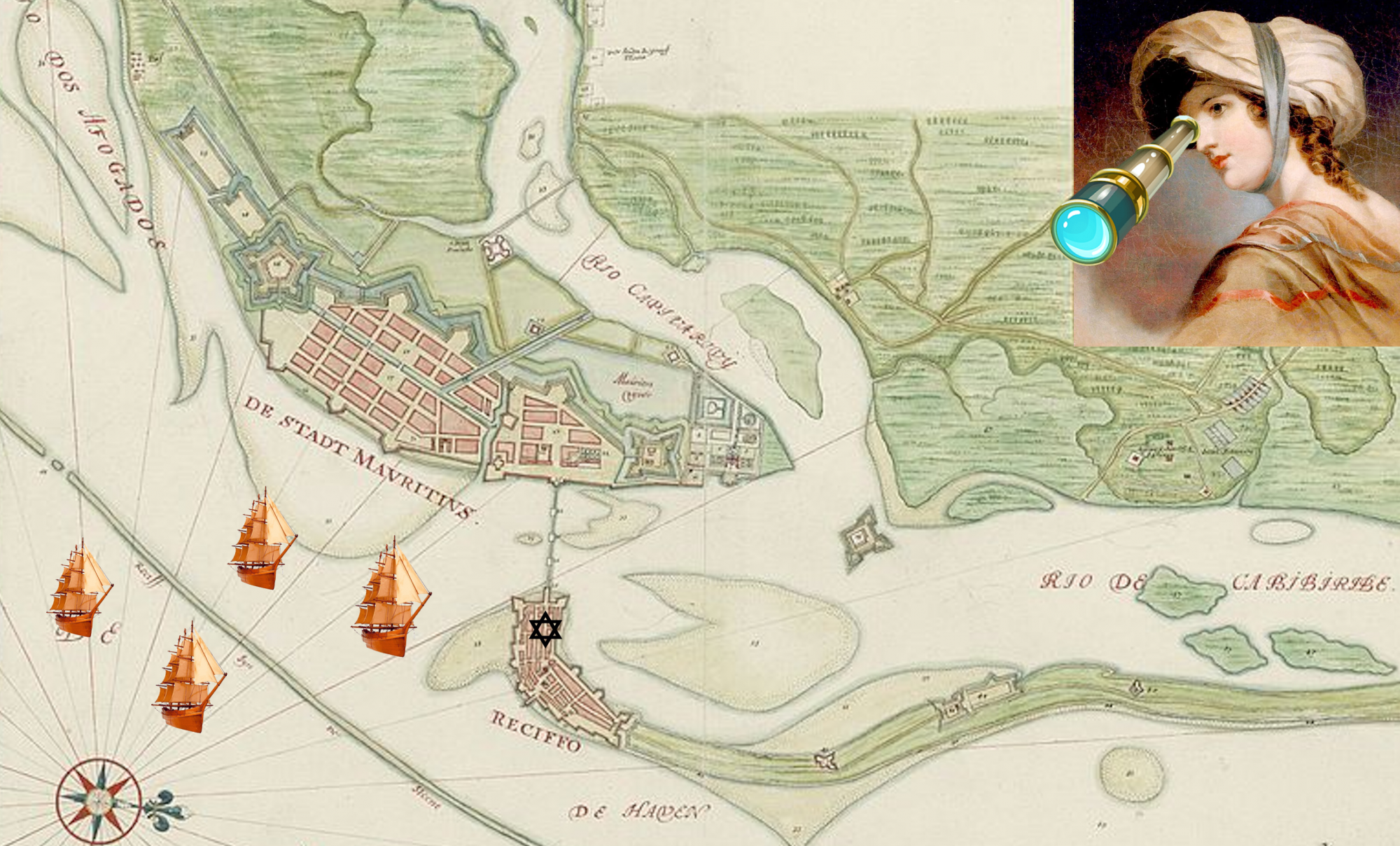

Aztec Codex. This is similar
to how Hernando Alonso
would have appeared to
Native Americans in Mexico.
The first Jews who came to the Americas had to practice Judaism in secret. They were conversos, descendants of forced converts who came to the Spanish colonies starting around 1519 with conquistador Hernán Cortés, the man who led the expedition that conquered the mighty Aztec Empire. One of the most famous men who helped Cortés, Bernal Diaz del Castillo, described how several Spanish soldiers were executed during the invasion because they were thought to be practicing Judaism in secret. One of these men was Hernando Alonso who had helped build the ships Cortés needed to invade the Aztec capital city of Tenochtitlan. Today Mexico City lies on the ruins of Tenochtitlan.

Hernán Cortés’s map of the Aztec city of Tenochtitlan. Hernando Alonso helped build the boats so that the Spaniards could reach the city.

The Inquisition would continue to be a problem for conversos in the Spanish colonies. Unfortunately the most detailed information we have about secret Jews comes from the Inquisition records. These documents detail the torture and punishment of people who dared to practice Judaism even though it was against the law.
One of the most famous families of conversos was that of Luis de Carvajal, a nobleman who arrived in New Spain (Mexico) in 1567. He settled in Monterrey, a remote area in northern Mexico where conversos found it easier to practice Judaism (see map above). In fact some people believe that as many as 75% of the initial settlers in Monterrey may have been secret Jews. Yet they could not hide completely: in 1589 the Carvajal family was imprisoned by the Inquisition.
Luis was sent to the Hospital de Convalescientes where he had to prove that he was a good Christian. His mother and sister arranged to have him transferred to the Colegio de Santa Cruz, a college for Aztec nobles in Tlateloco, the northern part of Mexico City where the women lived. There Luis was a teacher and a personal secretary to one of the priests, but at night he could be with his family. Life in the College was a miracle for Luis as he had access to the college’s library. “God filled my hands with treasures,” he later wrote. From the books he learned more about Jewish history and ideas, including Maimonides Thirteen Principles of Jewish Faith. Instead of becoming a “good Christian,” Luis became a better Jew!

Colegio de Santa Cruz 
Outside the Colegio de Santa Cruz today 
Inside the Colegio de Santa Cruz today 
Aztec ruins at the College 
Drawing of Montezuma by Luis’s Students 
Beautiful Codex Made by Luis’s students 
Tlateloco on Cortés’s map 
Library at the Colegio de Santa Cruz
Luis’s mother and sister also kept practicing Judaism in secret. Mexican playwright Sabrina Berman wrote a play about the Carvajal family in 1983. In it, she has Isabel Carvajal explain that Isabel only pretends to be a Catholic so that she can live and be a Jew in secret. Isabel says, “I am baptized, I go to mass. God pardons me because it’s all done in order to be able to love him secretly in the only law, the law for which I am ready to live and for which I am ready to die.”
Eventually the Inquisition found out what the family was really doing. Like her brother, sisters, and mother, Isabel was executed by the Inquisition for Judaizing in 1596. The Carvajal family and other early American Jews who preferred to die rather than give up Judaism inspired and saddened Sephardic Jews in Amsterdam and the colonies. Jews who were able practice Judaism openly lamented their tragic and unnecessary deaths of Jews killed by the Inquisition. You can read a poem by one Amsterdam Sephardic poet on this subject in the Reading section of Daily Life.

Elsewhere such as Guatemala, Cartagena, and Lima conversos were similarly imprisoned for practicing Judaism in secret, or sometimes simply because their ancestors were Jews. In Lima, the Inquisition threw Manuel Bautista Perez, a wealthy merchant, and his extended family in prison for practicing Judaism and for having a secret synagogue in his house. Bautista was burned at the stake in Lima in 1639. Today his beautiful house, la Casa de Pilatos is one of the treasures of colonial architecture in Lima.
Activity

One of the things that made the Inquisition so angry at the Bautista Perrez family besides their great wealth was the balconies on their house. Although today the house has balconies with large windows, the house used to have enclosed wooden balconies like these ones on the nearby Torre Tagle Palace. The Inquisition felt that with these balconies the Jews could watch people on the street but remain hidden themselves behind the latticework. On this account the Inquisition was right: the balcony protected the household from intruding eyes. In which room do you think they held their secret religious services?

In the space below, design a house for colonial conversos that includes privacy features like the balconies and secret rooms for holding synagogue services. When you are done you can download the image and email it to your teacher.
1. Add a floor plan.
Click on the canvas.
(If items you've put on top of your floor plan suddenly disappear, just click in a corner of the canvas.)

